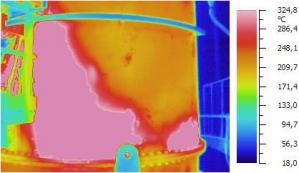The Hot Spot Repair service is executed by professionals following a unique and thorough procedure. Years of experience helps them to execute the job in a correct and safe way and within the shortest time possible.
The most common way to repair a hot spot involves high costs. Often the unit has to shut down (unplanned shutdown). An internal inspection and refractory repair of the unit is only possible after a cooling-down period. Usually a scaffolding is needed which has to be constructed and dismantled after the repair. All in all, an unplanned downtime of more than a week with high and unforeseen costs.
Two types of hot spots
 There are two different types of hot spots. The first type are relatively small hot spots due to irregularities in the refractory lining which causes damage to the lining. The second type are the hot spots which occur because the refractory lining is damaged over a larger area (or areas). Usually it is clear which type of hot spot it is. When in doubt, a thermal scan can be made to find out what the overall temperature and the size of the hot spot is. (See the picture on the right)
There are two different types of hot spots. The first type are relatively small hot spots due to irregularities in the refractory lining which causes damage to the lining. The second type are the hot spots which occur because the refractory lining is damaged over a larger area (or areas). Usually it is clear which type of hot spot it is. When in doubt, a thermal scan can be made to find out what the overall temperature and the size of the hot spot is. (See the picture on the right)
Procedure of Hot Spot Repair
The procedure of the refractory repair of the first type of hot spots is as follows:
- The first step is cutting small holes in the casing of the furnace, while the furnace remains in operation. When the holes have been made, couplings are welded on to the casing.
- A special developed injection mould is injected through the mounted couplings, filling the cracks in the refractory lining.
- The mould finds its way through the cracks and right away the temperature of the casing starts to drop.
- Because of the changing pressure and the experience of our professionals, we know when the gap is completely filled.
- The holes are closed and the repaired hot spot will remain colder than the rest of the surrounding area!
The second type of hot spots needs a different and more complicated approach. A special technique is used to completely fix the refractory lining.
- First, holes are cut into the casing to get access to the hot spot area. When necessary, another hole is drilled into the casing next to hot spot to get a good view from the inside using a camera. This is our special refractory Hot Spot Endoscopy technique.
- After determining the size and the difficulty of fixing the hot spot, the injection mould is pumped into the hole. This is where our special technique, that our specialist have developed and improved, comes in.
For more information, please contact us or have a look at www.insulcon.com


